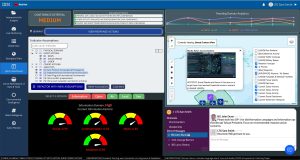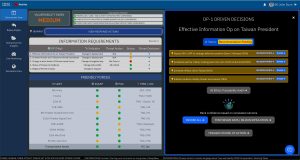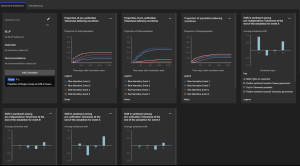Government
Navigating complexity: powering better-informed decision making with Improbable Defence’s Skyral and IBM’s DSaS
2 December, 2022 | Written by: Chris Nott and James East
Categorized: Government
Share this post:
Our lives are defined by unprecedented volumes of data. Massive data – what we used to call ‘big data’ – has propelled us into The Information Age and continues to drive unprecedented technological innovation. It’s transforming how we live, connect and operate.
Here’s one example. The Information Age has accelerated an unfortunate but perhaps inevitable byproduct: disinformation. You might even describe the second half of the 2010s as The Disinformation Age, with hostile actors interfering in democratic processes across the West.
The Greek playwright, Aeschylus, wrote: in war, the first casualty is the truth. Distorted narratives, propaganda and fake news have always been a feature of conflict, but in a world more connected than ever, the web-enabled prevalence of disinformation has fundamentally altered the character of war once again.
So our militaries, governments and service personnel must adapt to stay ahead.
They must have access to the latest technologies, tools and services to make sense of the information environment and so tackle challenges as quickly as they appear.
But there’s a problem: the process of digital transformation in defence is too slow. It struggles to match the pace of today’s fluid and fast-moving threats. Command centres and control tools rarely have the required analytical capability to turn data into useful information, and from there into actionable insights. Crucial capabilities are currently siloed, expensive to procure and difficult to adapt as threats evolve.
There is good news: thanks to continued collaboration across industry, government and academia, we’re beginning to speed things up. Programmes like the UK Ministry of Defence’s (MOD) recently launched Defence DevSecOps Service (D2S) stand as testament to their determination to adopt modern approaches to software delivery, converting technological capabilities we’ve built into an enduring strategic, military advantage.
One element of this advantage is powered by the latest modelling, simulation and defence synthetics capabilities. Through these, we’re injecting real-time situational awareness into the decision–making process at every level of the command chain to help them understand events as they happen, explore how they might evolve, and decide on the best course of action in response to these insights.
Changing how industry collaborates so defence can transform how it operates
D2S, launched under the UK MOD’s Digital Foundry, is a key enabler of this transformation. It provides an open–source standard framework for containerised applications and analytics workflows, and so enables the creation of modern tools that are fast to build and iterate in a more collaborative way.
As one of the early partners of D2S, Improbable Defence has been able to deploy and demonstrate the value of a complex synthetic environment application powered by Skyral, our synthetic environment (SE) development platform, running on D2S – itself built on IBM’s Red Hat OpenShift Kubernetes container platform.
D2S’ common environment facilitates interoperability between capabilities, providing users with the added flexibility, agility and the ability to provision tools and services as needed.
Together with IBM, Improbable Defence will integrate Skyral with the Defence Simulation Analytical Service (DSaS), a data management and governance platform built on Red Hat OpenShift, to provide a new way of collaborating in this area – faster, cheaper and easier than ever before. DSaS provides the technology and services to accelerate the on-boarding and convergence of data sources by harnessing AI for multi-domain situational awareness. IBM Cloud Pak for Data underpins this capability. Given that both technologies are cloud-enabled and already running on Red Hat OpenShift, they are ready to deploy and operate in modern defence environments like MOD’s D2S.
To illustrate the integration of DSaS with Skyral, we’ve generated a visualisation of a highly complex synthetic environment modelled on Taiwan and involving a simulated disinformation campaign. In this example, Skyral uses data processed through DSaS for richer, more rigorous modelling and simulation that enables planners and analysts to explore potential future scenarios. In so doing, their course of action analysis is more effective, enabling faster and better-informed decision making.
Virtual world experimentation for real world application: disinformation in Taiwan
Positive or negative sentiment can make or break an actor’s chance of success. It has load-bearing implications for the stability of a nation, so even minor changes in sentiment deserves attention. This means diving into the information domain, as our hypothetical planner does in the below representative scenario.

Image 1: Analyst gains situational awareness based on the indicators and assumption set around identifying disinformation.

Image 2: Based on priorities proposed using AI, the commander requests augmented decision support that could mitigate the disinformation operations
Given the importance of sentiment, it comes as no surprise to our planner that they receive a request from their commander, prompted by DSaS, to investigate an uptick in information operations targeted at a senior Tawainese politician. The planner is to produce a recommended course of action to support positive sentiment towards the politician. So they pour a fresh coffee, boot up the Skyral-powered synthetic environment and get to work.

Image 3: The planner reviews data on sentiment hotspots and social sentiments ingested and visualised using Skyral tools.

Image 4: They configure an experiment to run using Skyral, which simulates how news about the Taiwanese president spreads under different conditions.

Image 5: An experiment report is generated using Skyral’s analysis tools to understand the impact of this news on different groups in the population.
The provision of this type of capability is essential in ensuring our militaries and governments stay ahead of our adversaries. And these same organisations are all too aware of the immediacy of the threats we face. The NATO 2022 Strategic Concept, released in June, paints a stark portrait of a world rocked by ‘pervasive instability, rising strategic competition and advancing authoritarianism’. UK MOD’s Digital Strategy for Defence highlights similar challenges.
The implication is clear: organisations throughout NATO and allied forces need these capabilities now. Only then can we achieve the Alliance’s fifth principle: to ‘enhance our individual and collective resilience and technological edge’ in order to overcome threats to Western peace, safety and prosperity.
Services like D2S respond to this need. D2S is designed to hasten the development and deployment of software in defence to get the resultant technological innovation into the hands of those that need it most – fast.
Bringing Skyral and DSaS together and making them ready for deployment into solutions like D2S will accelerate our ability to deliver large and varied synthetic environments to end-users, providing them the means to make faster, better-informed decisions so they can tackle conflict in all its complexity.
More broadly, D2S and the Digital Foundry heralds the potential for profound transformation in defence. Through it, our militaries and service personnel will be able to harness the latest, most relevant and reliable content and data, draw on the latest modelling and simulation technologies, and work together to break down capability siloes.
For industry, this presents the perfect opportunity – and responsibility. If we can extend the transformative power of defence synthetics across all domains, we’ll establish genuinely robust and responsive strategies for all domains. That is a significant deterrent against any adversary.
For more information, visit the IBM Seismic Digital Sales room: https://ibm.biz/TechEdge

Global Technical Leader for Defence & Security

Business Development Director for IO Defence (Improbable)
Unlocking Digital Transformation in Government
As the UK government embarks on its digital transformation journey, the challenges of adopting new technologies such as artificial intelligence (AI) and data-driven solutions are becoming more evident. From managing public trust to overcoming fragmented systems, the path is complex. Blake Bower and Giles Hartwright review the unique obstacles that the government faces and […]
